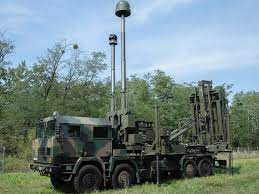“Flying at supersonic speeds, CAMM missiles can destroy modern air threats including stealth aircraft and high-speed missiles,” declared the British government, in a release. “Each CAMM family missile is equipped with an advanced active radar seeker that can see even the smallest, fastest and stealthiest targets through the worst weather and the heaviest electronic jamming.”
Those are two distinct claims. The first is that the CAMM missile is fast enough to hit other fast-moving targets, some of which may be stealthy. The second is that the CAMM missiles can see targets through weather and jamming.
MBDA lists CAMM as having a range of over 15 miles and of traveling at supersonic speeds, which is between 1 and 5 times the speed of sound. To find its targets, the CAMM can receive input from other systems, which should offer greater accuracy as more and newer sensors are added in. A data link between the missile and the launcher allows for the rapid upload of targeting information, and likely continuous transmission while in flight. Onboard, it has an active radio-frequency seeker, a kind of small radar that can direct it to a target.
Anti-air missiles are interception machines. Because they are directed at moving targets, the missiles have to track, adjust, and speed towards those targets in order to work as promised. The stakes, for a military relying on such missiles, are enormous. If the missile hits a plane, it prevents all future damage the plane was going to cause (except for wherever it crashes). If the missile misses, then the plane is free to wreak havoc and the window in which another missile can intercept it is much smaller.
Under the name Sea Ceptor, CAMMs are already in use by the Royal Navy. A land variant is also in the works for the British Army, and it is this land variant that will fit into the modernization plans of Poland’s military.
Anti-air missiles are not new, but they are part of a long and ongoing cycle of offense-defense escalation. As aircraft gain new advances, from better engines to the ability to fly at higher altitudes, new missiles have to be more capable to stop them, traveling faster and tracking more accurately. In response, planes feature countermeasures, like chaff, which are pieces of small metal blasted out of a plane to confuse the radar sensor of a targeting missile.
Stealth, made famous by planes like the F-117 Nighthawk and B-2 bombers used by the United States, is a proactive approach to hiding planes from radar. The geometry of the planes, as well as the materials used, reduces radar signatures. It’s effective, but it can still be engineered around, as weapons designers work on missiles and other linked sensors that can better make out deliberately faint signatures.
Source : https://www.popsci.com/technology/poland-receives-new-missile-defense-system/









